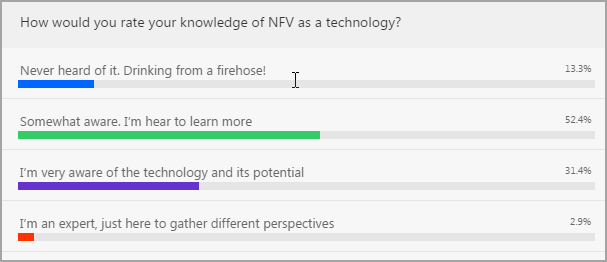D-NFV for enterprises: 5 key benefits
Time is the enemy in business today. And for enterprises, the clock always seems to run a bit faster. That’s because the tools at their disposal take just too much time to get up and running. Who has 6 to 18 months anymore to turn up a new network service to one their branch offices?
That’s sometimes what it takes when your new network service is implemented using legacy network appliances. These devices are fragmented, purpose-built hardware that require a physical installation on site – truck rolls waste time, money, and aren’t good for the environment, either!
Fortunately, there’s a better way. It’s called Distributed NFV (D-NFV).
If you’re like a lot of people, you probably just whispered to yourself, “What the heck is D-NFV?” In fact, in a recent webinar I hosted on D-NFV for Enterprises, over 65% of the attendees considered themselves new to the topic of D-NFV (see poll results below). Well, for those of you struggling to catch up on this burgeoning technology, take a look at my colleague Brian Lavallée’s article from last November, which provides a great overview.

Long story short, D-NFV essentially eliminates the lengthy periods of time that it takes to turn up new and existing services. There are five reasons that I think D-NFV makes sense as the next step in the evolution of rolling out services to the enterprise. They’re pretty simple:
1) It saves time: Providers can be more efficient while optimizing valuable network resources by adding, deleting, scaling, or reconfiguring high-speed connections in minutes (not the months it’s taken in the past).
2) It’s simpler: With D-NFV, trying new network services (ex. encryption) is as simple as being downloaded and evaluated. And if you don’t like it, you’re free to try another vendor’s Virtual Network Function (VNF), much like how you download and try apps on your smartphone today.
3) It’ll go wherever you need it: D-NFV enables the movement of various network functions to the network edge, often within a customer premise, when it makes sense. For instance, it just makes sense from a security perspective to encrypt data right within your office building before it leaves for its journey into the cloud.
4) It’s secure: Nothing gets the attention of enterprises more than the word “security.” D-NFV can protect connections into the cloud by leveraging such VNFs as encryption and firewalls.
5) It lowers capex and opex: The use of COTS hardware, readily available support personnel, and the massive automation of tasks results in what everyone wants - lower overall costs.
OK, so it’s fine for me to write a post and extoll the virtues of D-NFV. But what do other enterprises think?
For the enterprises we polled, half highlighted either complexity of management or capacity constraints as the biggest challenge to their deployment of WAN services. And they’re taking action. With new services like SD-WAN becoming increasingly popular.
Few developments have seen such quick uptake, but it also comes with some challenges.
Enterprises expect to have a choice of features, from simple to advanced, including encryption and highly accurate performance management (to pick two amongst dozens of VNFs). I’ve included illustrations of a couple of use cases, both Blue Planet-orchestrated VNFs. They illustrate some examples of the available options.
L2 and L3 network services use case

An IP router VNF connected via an Ethernet Business Service can provide connectivity with SLA enforcement for either Layer 2 or Layer 3, which is an enterprise requirement. By virtualizing network functions, savings in power and space is achieved by leveraging a shared hardware platform.
Highly secure network services use case

By service-chaining multiple VNFs together, such as encryption and a firewall, enterprises gain greater security control.
It’s clear that D-NFV is a big change in delivering traditional network services, but it’s important to provide enterprises with an experience that feels familiar. Enterprises expect virtual network service performance and security on par with, or better than, hardware appliance-based services.
Here at Ciena, we’ve been at the forefront of the development of D-NFV, so we understand it well. Ciena's D-NFVI Software is a complete, modular solution that’s specifically optimized for the Distributed NFV environment creating a purpose-built solution that’s simple, fast, secure, and less bloated (more about that in a future post).
I recently conducted a webinar on D-NFV, which we’ve archived here. Take a look and let us know what you think.
As I wrote in the open of this post, time is the enemy in today’s hypercompetitive marketplace across all enterprise verticals. But D-NFV is an interesting way to work around the immutable laws of physics by just doing things faster. It’s a fast-moving, exciting technology that’s constantly evolving. I encourage you to explore it with us.

